In the realm of problem-solving methodologies and creating business innovation and value, design thinking has emerged as a prominent approach that emphasizes empathy, collaboration, and iteration.
There is an ongoing debate between proponents and opponents regarding its effectiveness, but design thinking has the potential to revolutionize businesses across multiple industries. But before we can explore its effectiveness we must ask the critical question: “What is Design Thinking?”
This article will answer that question as well as explore the merits of the discipline, looking at arguments from both sides of the debate to provide a comprehensive understanding of its value for business innovation.
The Debate Surrounding Design Thinking
The efficacy of design thinking has sparked discussion among experts and practitioners.
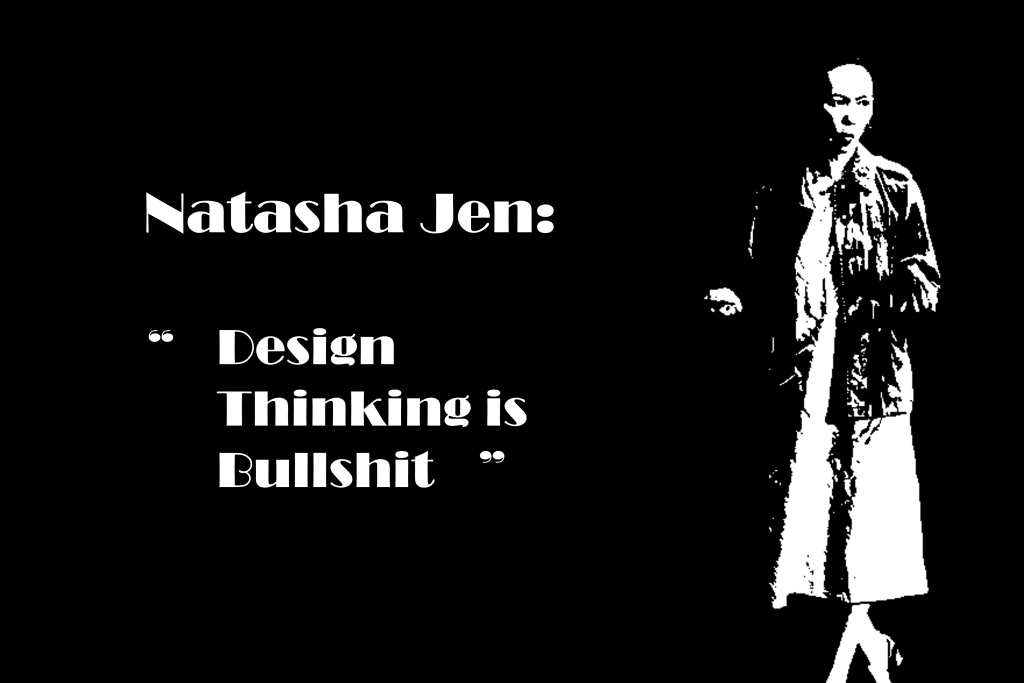
Opponents are bashing its proposition as a silver bullet or panacea that solves all problems for anyone. In her thought-provoking talk, “Design Thinking is Bullshit,” Natasha Jen critiques the superficial adoption and over-reliance on a linear process and Post-It notes that many practitioners exhibit.
What is Design thinking? A human-centered approach to innovation, drawing from the designer’s toolkit, integrating people’s needs, technology’s possibilities, and requirements for business success.
An article on the MIT Technology Review website also criticized the discipline, claiming that the focus is not on implementation but rather on providing recommendations that are far removed from the context for which they are designing.
Proponents and practitioners are quick on the draw to negate the arguments of detractors of the discipline, claiming that what they’re attacking isn’t what the practice really is. They point out that Jen’s criticism sheds light on the misuse of design thinking, but her argument primarily focuses on its misapplication, rather than dismissing the actual value of the methodology. Some of the proof they pose to support their conclusion is the fact that Jen strongly criticizes it for having only ONE tool: 3M Post-It Sticky Notes.
Any true Design Thinker knows that while some novices really do use sticky notes as their only tool, no true Design Thinker worth their salt does that.

Other examples of proponents of Design Thinking is a Harvard Business Review article titled “Why Design Thinking Works”, which offers a counterpoint by presenting evidence of its effectiveness. The article highlights successful applications in diverse industries, showcasing its ability to uncover deep customer insights, inspire innovation, and drive business success.
Most Design Thinking You’ll Come Across… Is (Sadly) Bullshit
If you look around any industry today, you’ll find practitioners who tend to approach the methodology extremely superficially, diluting its value. This tendency results in a proliferation of “design thinking buzzwords” and an overemphasis on rigid processes rather than embracing the core principles and values that underpin the methodology.
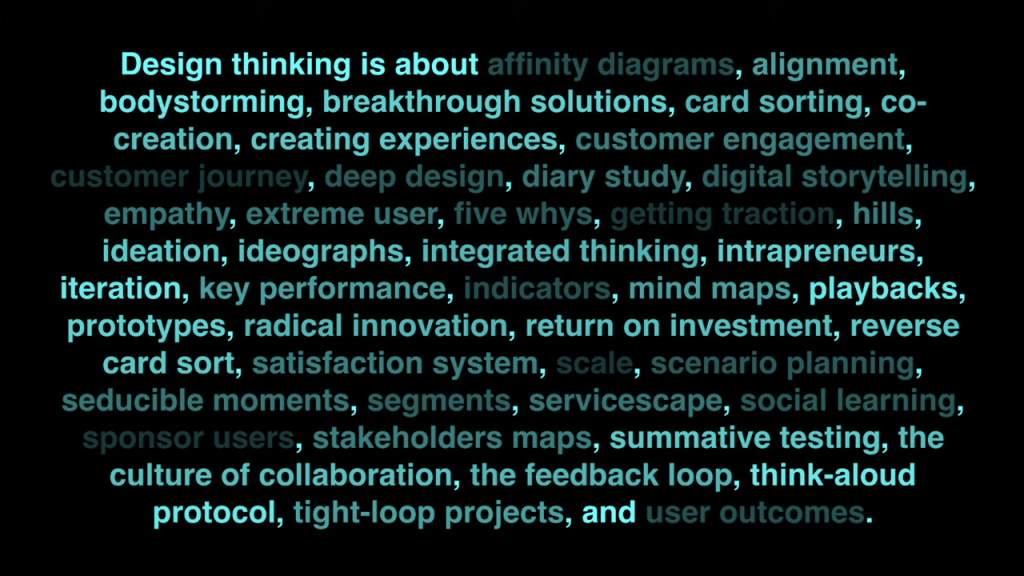
To unlock the transformative power of design thinking, practitioners must move beyond the surface-level aspects and adopt a mindset rooted in empathy, collaboration, ideation, prototyping, validation, and iteration. Only by cultivating a deep understanding of user needs and applying creativity in problem-solving can organizations fully harness the benefits.
What is Design Thinking? It is–theoretically–a “process”, and it’s diagrammatically linear. In reality, it’s messy, non-linear, loops back, and constantly builds and tests…
If opponents are attacking what many practitioners are doing (but that isn’t really what design thinking is) then we need to get our definitions straight and set the boundary for what it is, as it was originally conceived. To get a better view of the situation, its challenges, and its potential value, let’s take a few steps back and look at how we got here in the first place.
What is Design Thinking’s Origin?
Design thinking has its origins in the fields of engineering, architecture, and industrial design. It emerged as a problem-solving approach in the late 1960s and early 1970s. Pioneers such as Herbert Simon, a Nobel laureate in economics, advocated for a more user-centric approach to problem-solving, setting the foundation for the field’s development.
Stanford University’s Institute of Design (or d.school, created by David Kelley) played a crucial role in popularizing design thinking. Established in 2005, the d.school introduced it as a systematic framework for innovation and creativity. It integrated elements of empathy, ideation, prototyping, and iteration into a structured process, making the practice accessible to a broader audience.
What many design thinking practitioners are touting falls woefully short of what design thinking is.
What IS Design Thinking REALLY?
As a multidimensional concept, it has been defined and described in various ways. Who better to answer the question “What is Design Thinking?” than David Kelley, founder of the renowned design firm IDEO and a prominent advocate of design thinking and one of its founding fathers.

According to Kelley, it is a human-centered approach that combines the designer’s sensitivity and methods to match people’s needs with what is technologically feasible and viable from a business perspective.
Kelley’s definition emphasizes the importance of aligning user needs, technological possibilities, and business viability, providing a holistic view of design thinking’s purpose and potential.
Other definers include:
Tim Brown, Co-Chair of IDEO
Brown, a renowned design and innovation consultant, when asked: “what is design thinking?”, provides the definition as “a human-centered approach to innovation that draws from the designer’s toolkit to integrate the needs of people, the possibilities of technology, and the requirements for business success.”

Brown’s definition emphasizes the integration of human needs, technological possibilities, and business considerations, aligning with the multidimensional nature of the discipline.
Roger Martin, Author and Strategy Advisor
The prominent business thinker describes it as “integrative thinking in the service of breaking new ground.”

He highlights the importance of synthesizing diverse perspectives and different disciplines and ideas to drive creative problem-solving and uncover innovative solutions.
Jeanne Liedtka, Design Thinking Expert
Liedtka is a professor at the University of Virginia’s Darden School of Business.

She defines design thinking as “a human-centered, iterative problem-solving approach that blends empathy, experimentation, and collaboration to create innovative solutions”, also focusing on iteration, empathy, experimentation, and collaboration to achieve innovation.
IDEO U, online learning platform
This online university was founded by IDEO, one of the most prominent design firms in the globe. It is always worthwhile to observe their perspective on any topic within the design field.

What is design thinking according to IDEO? It is “a process for creative problem-solving that starts with understanding people’s needs and involves generating ideas, building prototypes, and testing concepts with users”, underscoring an iterative nature involving empathy, ideation, prototyping, and user testing to arrive at innovative solutions.
These definitions give us a broad understanding of design thinking as a human-centered, integrative, and iterative approach to problem-solving that combines empathy, creativity, collaboration, testing, and experimentation to drive innovation.
Successfully applying Design Thinking in diverse industries showcases its ability to uncover deep customer insights, inspire innovation, and drive business success.
Now that we know what it is, let’s take a look at how it’s done.
The Design Thinking Process
Design thinking is a “5-step process” that commonly goes like this:
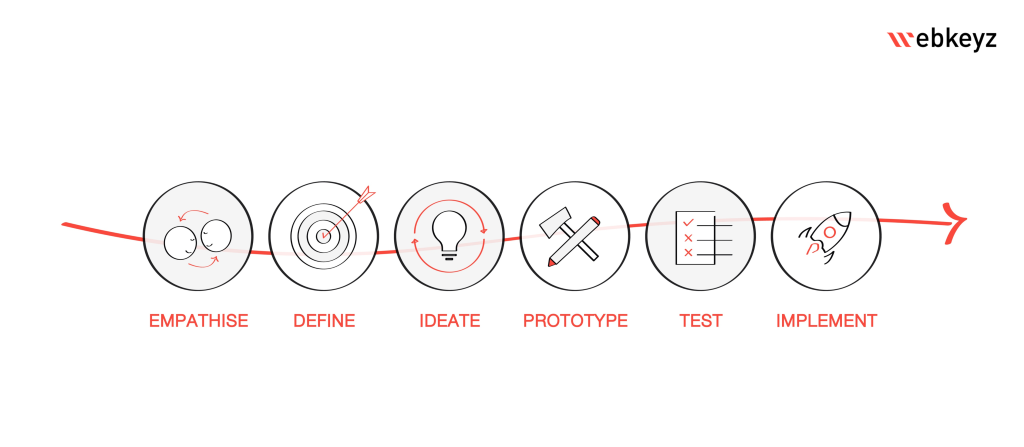
- Empathize: Design thinking begins with empathizing with the target audience or users to gain a deep understanding of their needs, desires, and challenges. This stage involves conducting user research, interviews, observations, and immersing oneself in the users’ experiences.
- Define: Once insights are gathered, the next step is to define the core problem or opportunity based on the user research. This stage involves synthesizing information, identifying patterns, and reframing the problem in a human-centered way.
- Ideate: During the ideation stage, teams brainstorm and generate a wide range of creative solutions. The emphasis is on quantity, suspending judgment, and encouraging a free flow of ideas. Techniques like brainstorming, mind mapping, and sketching are commonly employed to stimulate creativity.
- Prototype: In this stage, ideas are translated into tangible representations. Prototypes can take various forms, such as physical models, wireframes, storyboards, or even role-playing scenarios. The goal is to quickly create low-fidelity prototypes that can be tested and refined.
- Test: Prototypes are shared with users or stakeholders for feedback and evaluation. This stage involves gathering insights, observing user interactions, and refining the solution based on feedback received. Iterative testing allows for continuous improvement and a better understanding of user needs.
Notice the quotations around “5-step process”?
That’s because the Design Thinking process is only a “process” in the most theoretical sense and is only linear for diagrammatic purposes.
Any Design Thinking practitioner knows that some novices might use sticky notes as their only tool. No true Design Thinker worth their salt does that.
Traditionally, it’s been represented as the linear process above, but more recently it’s been looking like this:
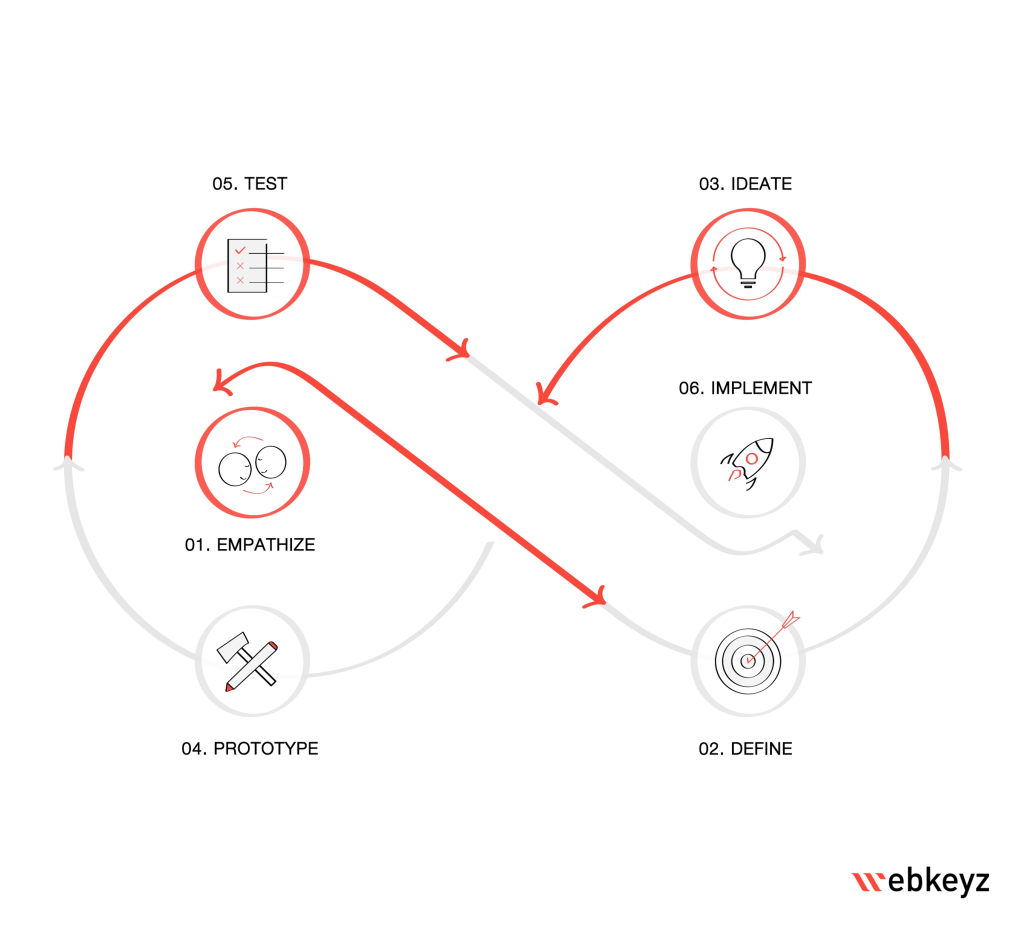
And these diagrams only attempt to simplify things to communicate them clearly, imagining a pristine and perfect world where one phase leads smoothly into another. In reality, the “design thinking process” goes something like this:
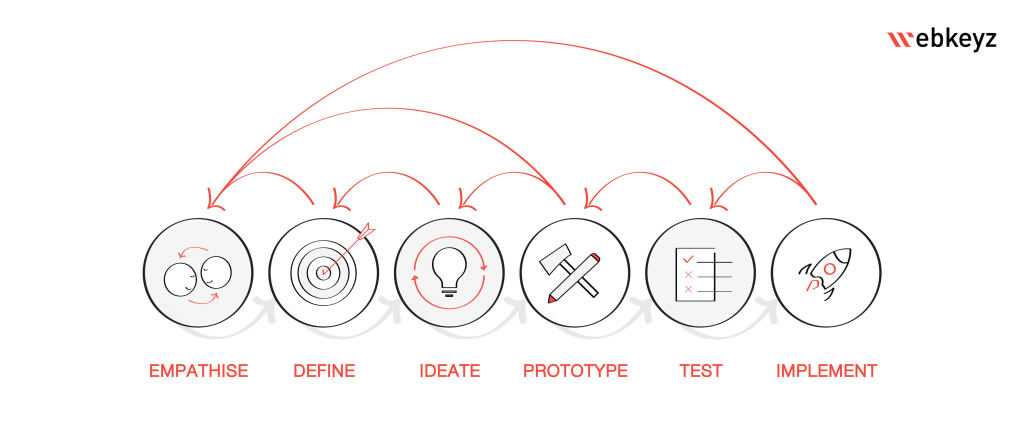
It’s messy, it’s non-linear, it loops back on itself, and it involves constant building and testing… just like you’d expect a creative innovation process to be (wink, wink @NatashaJen).
“What Are They Actually Doing?” Vs “What is Design Thinking?”
Just like all businesses claim to want innovation, many claim they want or apply design thinking. The devil is in the details, though.
What many design thinking practitioners are touting falls woefully short of what it should be. While design thinking has gained widespread popularity as a problem-solving approach, many practitioners tend to exhibit a superficial understanding and application of the methodology. This superficial approach can undermine the potential effectiveness and impact of design thinking (and honestly, it gives the whole practice a bad name). Here are some common examples of superficial application:

- Lack of Empathy: Design thinking relies heavily on empathy to understand the needs and experiences of users. However, some practitioners may overlook or downplay the importance of empathetic research and instead rely on assumptions or generalizations about users. Without a deep understanding of users’ perspectives, the resulting solutions may not effectively address their needs.
- Improper Definition, Fuzzy Problem Statement, or Poor Questioning: Design thinking requires accurately defining the problem, analyzing user statements for insights, and posing “how might we” questions that guide the ideation process. A lack of clarity in these activities results means you’re probably not solving the real problem.
- Superficial Ideation and Brainstorming: Ideation is a critical phase of design thinking where diverse ideas are generated. And rich, nuanced ideation is not achieved through brainstorming! It needs a lot more structure. Resorting to surface-level ideation through brainstorming sessions without fostering a truly creative and open-minded environment can lead to a limited range of ideas and missed opportunities for innovative solutions.
- Failure to Iterate and Test: Design thinking emphasizes an iterative process of prototyping and testing. However, practitioners may rush through this stage or overlook it entirely. Without proper iteration and testing, the solutions developed may not be refined and may fail to address users’ needs effectively.
- Overemphasis on Visual Tools with Little Analysis: Design thinking often employs visual tools such as personas, journey maps, and prototypes to facilitate understanding and communication. However, some practitioners may focus solely on creating visually appealing artifacts without delving deeper into the underlying insights and user-centered decision-making.
- Neglecting Organizational and Systemic Factors: Design thinking is not only about developing innovative solutions but also about considering the broader organizational and systemic factors that influence their implementation. Superficial practitioners may fail to address these contextual elements, resulting in solutions that struggle to be integrated or sustained within existing systems.
To unlock the power of design thinking, we must move beyond the surface, adopting a mindset rooted in empathy, collaboration, ideation, prototyping, validation, and iteration.
To truly unlock the potential of design thinking, it is crucial for practitioners to move beyond superficial application and embrace the methodology’s core principles. This includes developing a deep sense of empathy, fostering a culture of collaboration and creativity, iterating and testing solutions, and considering the broader organizational and systemic context. By doing so, practitioners can harness the full power of design thinking to create meaningful, user-centric, and impactful innovation.

Wrapping Up
So we’ve answered the question: “What is design thinking?”, and we’ve seen the debate surrounding design thinking between those who think it’s bullshit, and those who swear it works, and those who are essential making a quick buck by peddling bullshit. We’ve seen how it came about and what it is and what it isn’t.
If you want to find out whether design thinking really works, check out our article where we explore that question, uncovering the evidence behind the discipline and whether it really is a panacea for all the world’s problems.
Until next time.
Keep Thinking!








